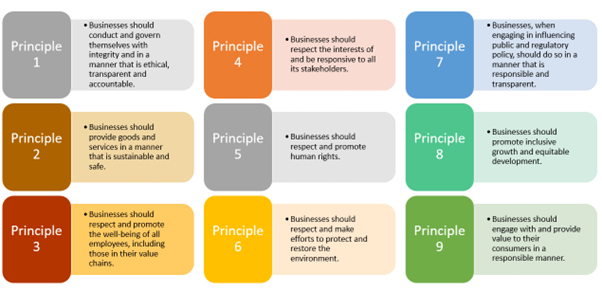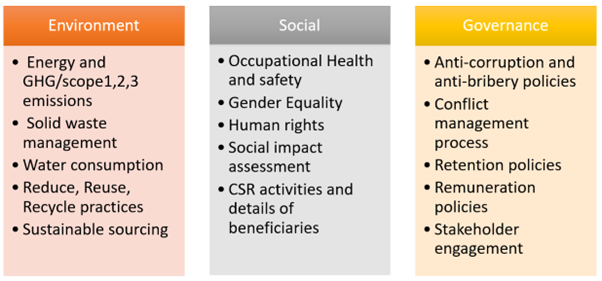
- SAP Community
- Groups
- Interest Groups
- Sustainability
- Blogs
- Business Responsibility and Sustainability Report ...
Sustainability Blogs
Delve into SAP sustainability blogs. Gain insights into tech-driven sustainable practices and contribute to a greener future for businesses and the planet.
Turn on suggestions
Auto-suggest helps you quickly narrow down your search results by suggesting possible matches as you type.
Showing results for
Nishikant-SAP
Participant
Options
- Subscribe to RSS Feed
- Mark as New
- Mark as Read
- Bookmark
- Subscribe
- Printer Friendly Page
- Report Inappropriate Content
01-08-2024
6:59 AM
Sustainability today is a core business imperative. Disclosure mechanism globally in the last decade, holding companies accountable for their identification of Environment, Social and Governance (ESG) responsibilities.
In line with these global improvements, the Securities and Exchange Board of India (SEBI) has introduced new requirements for sustainability reporting by listed companies. The new reporting format, called the Business Responsibility and Sustainability Report (BRSR), aims to make connections between a company's financial performance and ESG performance. This makes it easier for regulators, investors and other stakeholders to get a fair assessment of the company's overall stability, growth and sustainability. SEBI has allowed BRSR to be implemented for top 1,000 listed companies (by market capitalization) to report voluntarily from FY 2021-22 and mandatory from FY 2022-2023.
BRSR (Business Responsibility and Sustainability Reporting) is a framework designed by SEBI (Securities and Exchange Board of India) to encourage companies to integrate sustainable and responsible business practices into their operations.
Journey Of ESG in India –
Below figure explained how, Voluntary Guidelines on Corporate Social Responsibility, published by the Ministry of Corporate Affairs (MCA) in 2009 and how it gets ESG journey evolved significantly since then. The reporting landscape has started and come a long way with the introduction of Business Responsibility Reporting (BRR), Corporate Social Responsibility (CSR), IR, National Guidelines on Responsible Business Conduct (NGRBC) and now Business Responsibility and Sustainability Report (BRSR).
Structure of BRSR –
As per standard structure of BRSR it has three sections along with 9 principles –
Section A: General disclosures –
This section contains details of the listed entity, products/services, operations, employees, holding, subsidiary and associate companies (including joint ventures), CSR, transparency and disclosure compliances.
Section B: Management and processes disclosures –
It contains questions concerning policy(ies) and management processes, governance, leadership and administration.
Section C: Principle-wise performance disclosures –
In this section, companies are required to report upon KPIs in alignment with the nine principles of the National Guidelines on Responsible Business Conduct (NGRBC) .
Essential indicators (mandatory):
These are the indicator (KPIs) which company mandatorily needs to report which include data on training programmes conducted, environmental data on energy, emissions, water and waste, social impact generated by the company.
Leadership indicators (voluntary):
These are the indicator which companies are expected to comply for better accountability and improved transparency purpose. Few of KPIs include data on life cycle assessments (LCAs), details on conflict management policy, additional data on biodiversity, breakup of energy consumption, Scope 3 emissions and supply chain disclosures.
BRSR contains ESG concepts in its disclosure formats. The KPIs mentioned in the report can be divided into three pillars, i.e. E, S and G
How SAP supporting to create BRSR report -
SAP currently provides, SAP Sustainability Control Tower as foundational solution. It offers major functionalities aligned to what customers need.
This is a software-as-a-service solution that allows customers to embed sustainability into their business processes with current data and insights and achieve automated, auditable, and compliant reporting. Companies also want to measure ESG data which often spread across multiple data sources, format. Companies are also eager to their transition to move from averages to actuals to them bring their supply chain partners to joint this sustainability mission.
SAP Sustainability Control Tower currently offers forty-seven standard ESG metrics on pre-built models to support reporting framework such as BRSR and other.
Will see more details how ESG Metric can be reported from SCT for BRSR reporting in next blog.
In line with these global improvements, the Securities and Exchange Board of India (SEBI) has introduced new requirements for sustainability reporting by listed companies. The new reporting format, called the Business Responsibility and Sustainability Report (BRSR), aims to make connections between a company's financial performance and ESG performance. This makes it easier for regulators, investors and other stakeholders to get a fair assessment of the company's overall stability, growth and sustainability. SEBI has allowed BRSR to be implemented for top 1,000 listed companies (by market capitalization) to report voluntarily from FY 2021-22 and mandatory from FY 2022-2023.
BRSR (Business Responsibility and Sustainability Reporting) is a framework designed by SEBI (Securities and Exchange Board of India) to encourage companies to integrate sustainable and responsible business practices into their operations.
Journey Of ESG in India –
Below figure explained how, Voluntary Guidelines on Corporate Social Responsibility, published by the Ministry of Corporate Affairs (MCA) in 2009 and how it gets ESG journey evolved significantly since then. The reporting landscape has started and come a long way with the introduction of Business Responsibility Reporting (BRR), Corporate Social Responsibility (CSR), IR, National Guidelines on Responsible Business Conduct (NGRBC) and now Business Responsibility and Sustainability Report (BRSR).

Jounery of ESG in India
Structure of BRSR –
As per standard structure of BRSR it has three sections along with 9 principles –
- Section A
- Section B
- Section C

Structure of BRSR
Section A: General disclosures –
This section contains details of the listed entity, products/services, operations, employees, holding, subsidiary and associate companies (including joint ventures), CSR, transparency and disclosure compliances.
Section B: Management and processes disclosures –
It contains questions concerning policy(ies) and management processes, governance, leadership and administration.
Section C: Principle-wise performance disclosures –
In this section, companies are required to report upon KPIs in alignment with the nine principles of the National Guidelines on Responsible Business Conduct (NGRBC) .
Essential indicators (mandatory):
These are the indicator (KPIs) which company mandatorily needs to report which include data on training programmes conducted, environmental data on energy, emissions, water and waste, social impact generated by the company.
Leadership indicators (voluntary):
These are the indicator which companies are expected to comply for better accountability and improved transparency purpose. Few of KPIs include data on life cycle assessments (LCAs), details on conflict management policy, additional data on biodiversity, breakup of energy consumption, Scope 3 emissions and supply chain disclosures.

Nine-principle
BRSR contains ESG concepts in its disclosure formats. The KPIs mentioned in the report can be divided into three pillars, i.e. E, S and G

How SAP supporting to create BRSR report -
SAP currently provides, SAP Sustainability Control Tower as foundational solution. It offers major functionalities aligned to what customers need.
This is a software-as-a-service solution that allows customers to embed sustainability into their business processes with current data and insights and achieve automated, auditable, and compliant reporting. Companies also want to measure ESG data which often spread across multiple data sources, format. Companies are also eager to their transition to move from averages to actuals to them bring their supply chain partners to joint this sustainability mission.
SAP Sustainability Control Tower currently offers forty-seven standard ESG metrics on pre-built models to support reporting framework such as BRSR and other.
Will see more details how ESG Metric can be reported from SCT for BRSR reporting in next blog.
- SAP Managed Tags:
- Sustainability
1 Comment
You must be a registered user to add a comment. If you've already registered, sign in. Otherwise, register and sign in.
Labels in this area
-
Banking
1 -
BTP for Sustainability
2 -
Circular Design
1 -
Circular Economy
1 -
Compliance
1 -
CSRD
1 -
EPR
1 -
ESG
1 -
ESRS
1 -
Financial Services
1 -
Insurance
1 -
Packaging
1 -
PCAF
1 -
Picking Strategy
1 -
Plastic Taxes
1 -
Recyclability
1 -
SAP Analytics Cloud
1 -
SAP Cloud for Sustainable Enterprises
1 -
SAP Community
1 -
SAP Datasphere
1 -
SAP Profitability and Performance Management
1 -
SAP Responsible Design and Production
1 -
SAP SCT
1 -
SAP Sustainability Control Tower
2 -
SAP Sustainability Footprint Management
1 -
SCT
1 -
Sustainability
1 -
Sustainability Control Tower
1 -
Sustainable Finance
1